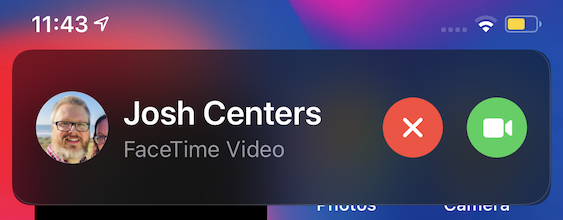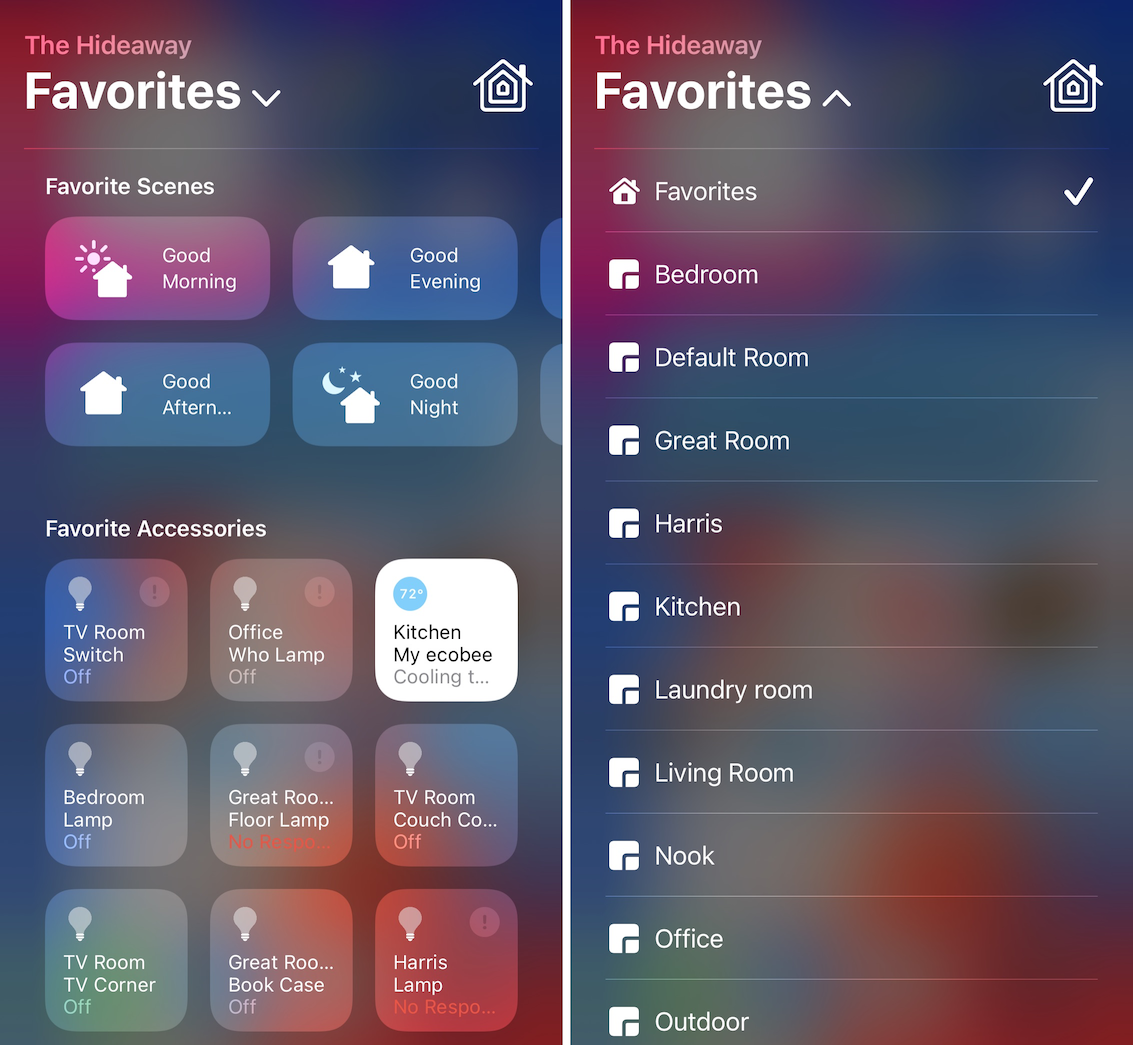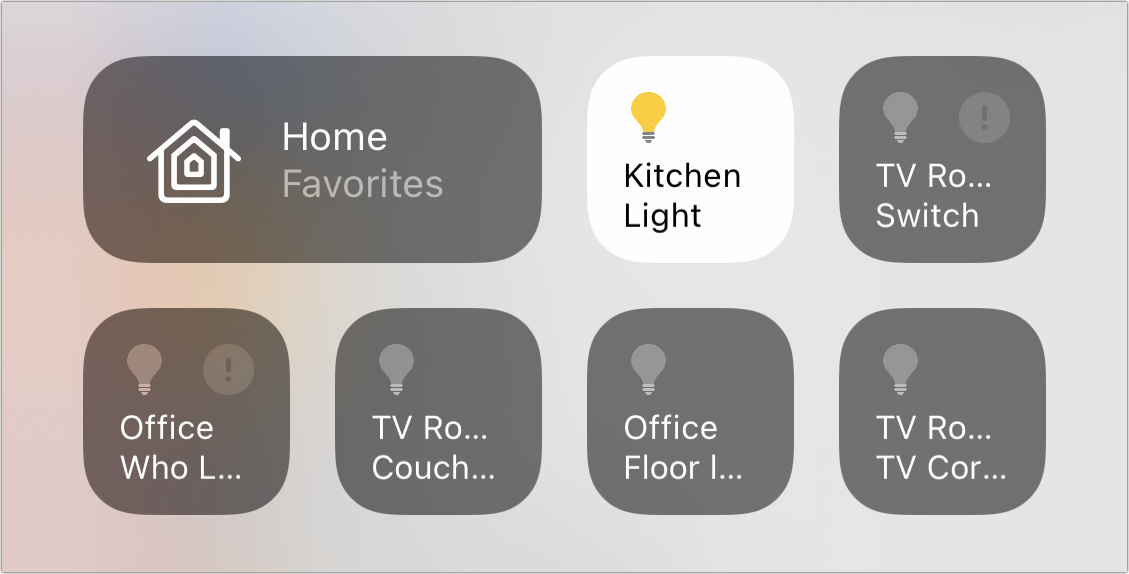Miscellaneous New Features
I usually kick off each new edition of this title with a lengthy, detailed list of new features. However, Apple has done a much better job in recent years of detailing all the new features of iOS and iPadOS. Also, this book focuses exclusively on how to use the new features of these operating systems.
However, there are a few non-interactive or otherwise minor features that I’d like to point out that don’t fit into any of the chapters.
Compact UI
Apple has shrunk many screen-hogging features in iOS 14 and iPadOS 14 so they no longer dominate your screen. For example, when you receive a phone call in iOS 14, it shows up as a banner instead of taking over your entire screen (Figure 10).

The same is true with Siri. A swirly Siri globe appears at the bottom of the screen instead of taking everything over (Figure 11), with answers appearing in a box at the top of the screen.

While search in iOS 14 still takes up the entire screen, search in iPadOS 14 is more like Spotlight in macOS, appearing as a gray bar (Figure 12).

iPad Design Changes
iPadOS has received a number of design tweaks to make it more Mac-like (as the Mac becomes increasingly iPad-like). Sidebars have a rounder look, the date picker has been redesigned to let you interact with an onscreen calendar instead of virtual wheels, popovers disappear when you tap outside them, and many onscreen controls have been consolidated into a single toolbar. The changes are largely cosmetic and minor, but they’re nice touches.
Search Improvements
Search has improved overall in iOS 14 and iPadOS 14. Apple calls a new aspect of Search “Top Hit results,” which translates to “search brings up the stuff you want,” which is how it was supposed to work in the first place!
Among other things, web search in Spotlight actually works now—just type your query into the iOS or iPadOS search field and it’ll open it up in Safari in your default web search engine.
Search now also pulls up results as you type.
Memoji Customization
Remember Memoji? In case you forgot, they’re cartoon avatars you can create for yourself and use in various places. There are many more customization options, including new hairstyles, headwear, age offerings, and face coverings (Figure 13).

If you want to play with these, here’s how:
Open Messages.
Tap the Memoji
 icon in the app bar above the keyboard.
icon in the app bar above the keyboard.Swipe right to move all the way to the left.
Tap New Memoji.
Assign Tasks in Reminders
You can now assign tasks to other people in shared Reminder lists. Here’s how:
Open a shared list in Reminders.
Tap the item you want to assign.
Tap the i
 button.
button.Tap Assign Reminder.
Choose one of the people the list is shared with.
Whoever has the task assigned to them can see it in an Assigned to Me smart list.
To learn more about Reminders, see Scholle McFarland’s Take Control of Calendar and Reminders, which will soon be updated to cover iOS 14 and iPadOS 14.
Smarter Siri
In addition to being less of a screen hog, Siri is a lot smarter in iOS 14 and iPadOS 14. It now has 20 times more facts than it did three years ago, including many more answers from the web that Siri can offer directly instead of sending you to a webpage. The new Siri voice, introduced in iOS 13, is now available in several new languages, and Siri can now translate between over 65 language pairs.
Default Web Browsers and Email Clients
iOS 14 and iPadOS 14 adds a long-requested feature: the option to set third-party apps as the default browser and default email client. Browsers and email clients will have to be specifically approved by Apple to be authorized to replace Safari or Mail, and there will be settings in the apps themselves to make them the defaults.
9to5Mac got an early look at how this feature will work.
Car Keys
You can use your iPhone in place of your car keys, at least in theory. This feature was announced for iOS 14, but actually arrived early in iOS 13.6. See the TidBITS article iOS 13.6, iPadOS 13.6, macOS 10.15.6, watchOS 6.2.8, and tvOS 13.4.8 Add News Features, Car Keys, Symptom Tracking.
Once you’ve used the automaker’s app to pair your iPhone to the car, you can hold your iPhone or Apple Watch next to the door handle to unlock the car. To start the car, you place your iPhone in the car’s key reader or hold your Apple Watch near the reader, and press the car’s start button.
You can also go into the Wallet app to share keys with other iPhone users. You can revoke keys at any time, and you can also place restrictions on how your car is used, like limiting the accelerator, top speed, and stereo volume. For more details, see the Apple support article “Use your iPhone or Apple Watch as a car key.”
Unfortunately, this feature has to be built into the car, and so far the only models supported are select BMW models produced after July 1, 2020.
AirPods
The AirPods Pro now support Spatial Audio, which is like virtualized surround sound. Spatial Audio uses the gyroscope and accelerometer in the AirPods Pro to track your head’s motion and actively remap the sound field as you move.
AirPods (second-generation and later) now also automatically switch between devices as you change the Apple device you’re using. You also receive notifications when your battery is low.
There is also a new feature called Headphones Accommodations that let you tune your AirPods to help you better understand certain sounds. See Tune Your AirPods.
HomeKit in Control Center
iOS 14 and iPadOS 14 fix one of my biggest HomeKit annoyances. In iOS 9, there was a special Control Center page just for favorite HomeKit accessories and scenes, and it held as many of either as you’d want to add. For some reason, when Apple overhauled Control Center in iOS 10, they changed it such that you could only access nine of each kind of favorite. This was super annoying, because I have a lot of accessories I want quick access to! It was almost as if Apple was punishing you if you bought too many HomeKit accessories.
Thankfully, that is now fixed in iOS 14. When you tap the Home button in Control Center, it not only shows all of your favorites on a separate screen, but also has a drop-down menu so you can access any room you want (Figure 14). You can add or remove Home in Settings > Control Center.

Another new thing is that Control Center now tries to guess which accessories you may want to control at any given time, and display those automatically (Figure 15). I’m not entirely convinced that these are useful, but they take up a lot of room. You can turn this feature on or off with Settings > Control Center > Show Home Controls.

Home Status at the top of the Home screen in Home has been overhauled. Instead of just a block of text, your Home’s status messages are displayed as interactive buttons (Figure 16).

A new feature lets you adjust the color tint of smart bulbs throughout the day. Think of it like Night Shift for your home. Great idea, but as of publication time, I had yet to see this feature in a beta release.
There are also a lot of new features regarding HomeKit security cameras in iOS 14, which I plan to cover in a future update to Take Control of Apple Home Automation.
Access AFPS Encrypted Drives in Files
Here’s a welcome feature: you can now access APFS-formatted encrypted drives in the Files app. Unfortunately, that doesn’t include drives encrypted using Apple’s old HFS+ format.
